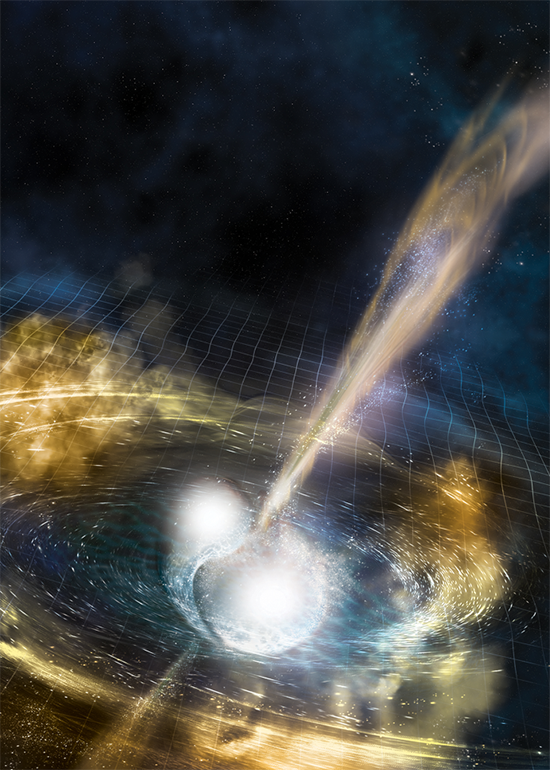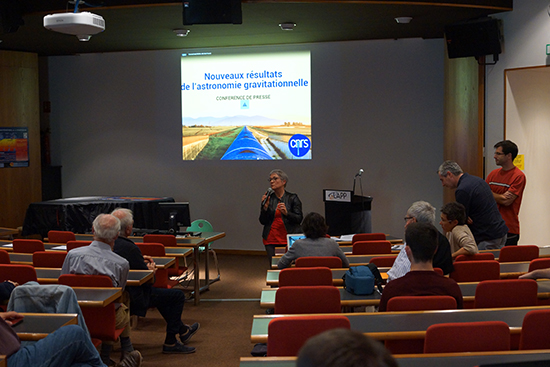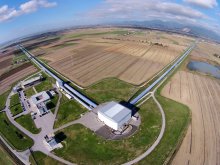A story of two neutron stars told by several cosmic messengers
At a press conference given at the CNRS headquarters, scientists from the LIGO-Virgo collaboration announced the first observation of gravitational waves from binary neutron stars. Contrary to the black hole fusion observed previously, this new source emits light which has been observed up to weeks after by 70 observatories on earth and in space. All these observations mark the beginning of a new astronomy, the “multi-messenger” astronomy.
On August 17th 2017 at 2.41 p.m. (Paris time), the LIGO-Virgo collaboration (in which LAPP takes part) observed a gravitational waves signal of a new type. The detailed analysis of the data indicates that the masses of the 2 objects lies between 1.1 and 1.6 solar masses, which corresponds to neutron stars. Neutron stars are remains of massive stars. A giant star dies in an explosion called supernova. After the explosion the only remain is a dense core composed almost exclusively by neutrons – a neutron star. Its size is that of a city like London but a spoonful of its matter weights one billion of tons. Like ordinary stars, some evolve in couple, orbiting around each other. They slowly get closer, losing energy in the form of gravitational waves – a phenomena which accelerates until the fusion. This scenario, predicted by models, is observed for the first time!

Almost at the same time, in an independent way, the Fermi satellite from NASA registers a gamma ray burst – a highly energetic emission – and immediately sends an automatic alert. In parallel, this source is localized in the sky by exploiting the arrival time and the amplitude of signals measured by the three gravitational wave detectors (the two LIGO detectors in the US and Virgo in Europe). The area, which covers about 30 degree square1 in the Hydra constellation is tens of times smaller than that determined by Fermi. It was communicated to 90 groups of associate astronomers, asking them to target it with their telescopes. Thanks to the American telescope Swope in Chile, a new light point was discovered in the NGC 4993 galaxy, 130 million light-years from Earth. Very soon, many other telescopes confirmed this result independently. The object has never been observed before and is formed of very hot matter that cools and whose luminosity quickly decrease.
According to the models, the fusion of two neutron stars ejects material that hosts nuclear reactions. These reactions lead to the formation of atomic nucleus heavier than iron (such as gold, lead…), thanks to the abundance of neutrons. This material emits light, initially blue and becoming red as it cools and spreads out. This phenomenon, called kilonova, is probably the main process of formation of the heaviest chemical elements in the Universe! The observation of kilonovae will allow us to determine in a new way the expansion rate of the Universe.
The LAPP team is strongly involved in every scientific aspect of the Virgo project, with important responsibilities in the conception, realisation and installation of the detector. It is also involved in the data analysis and played a part in the data collecting while ensuring the proper functioning of the detector.

Benoît Mours, CNRS researcher at LAPP and French responsible scientist in Virgo was one of the main speakers in today’s press conference at the CNRS headquarters. About 60 persons went at the live broadcast at LAPP.
LAPP researchers from Virgo and HESS groups are among the autors of the publication that summarises all the observations. About fifty scientific publications are currently in preparation.
1 120 times the size of the full moon in the sky.
Contact: Frédérique Marion
Further information:


